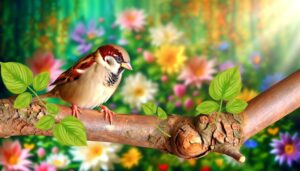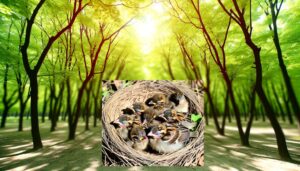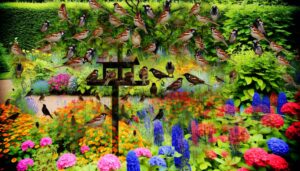What Does the Presence of Grey Sparrows at My Window Ledge Mean?
Grey sparrows at a window ledge typically search for food sources like crumbs, seeds, and insects. These birds are skilled at utilizing urban environments, especially human-provided feedings.
Sparrows also prefer window ledges for nesting, using materials such as grass and feathers. Their behavior can vary with seasons and weather, making them indicators of environmental health.
Sparrows' presence may indicate a well-balanced ecosystem, as they respond sensitively to changes in air quality. Their visits hold cultural symbolism and may convey various spiritual meanings.
To explore further details on sparrow behaviors and implications, refer to more extensive studies on their patterns.

Key Takeaways
- Grey sparrows visit window ledges for accessible food sources like crumbs, seeds, and insects.
- Their presence can indicate a balanced urban environment with available nesting and feeding opportunities.
- Sparrows symbolize different meanings in cultures, often associated with resourcefulness and community.
- Seasonal and weather patterns influence their behavior and frequency of visits to window ledges.
- Providing or removing food sources can encourage or deter their visits based on personal preference.
Common Reasons for Sparrow Visits
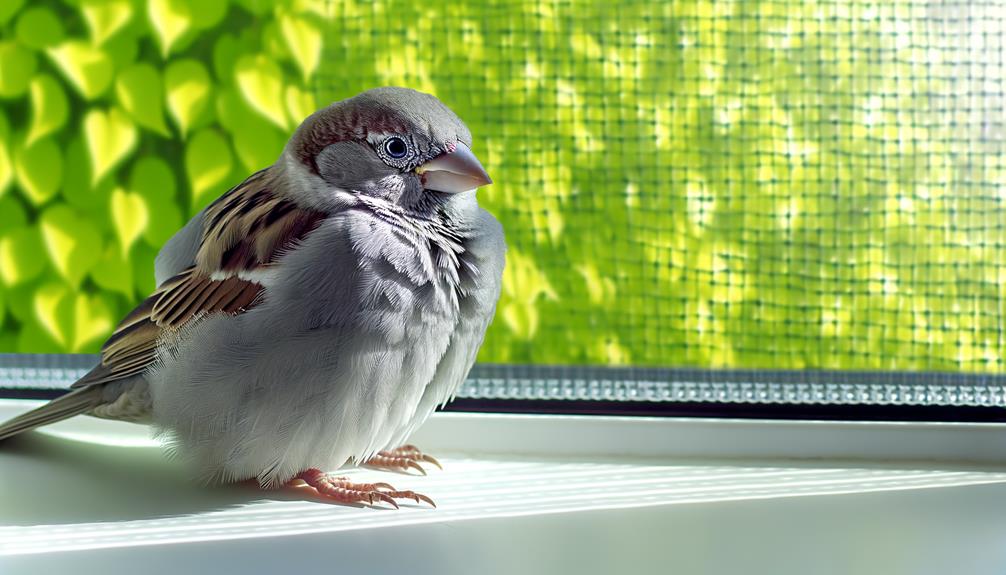
Grey sparrows often visit window ledges in search of food sources, such as crumbs or seeds, that might be readily available. Studies indicate that urban environments provide abundant resources, making window ledges appealing for these birds.
Observations reveal that sparrows are highly adaptable, exploiting human-provided food with remarkable efficiency. They're drawn to areas with consistent food supplies, leading to frequent visits. Additionally, the reflective surfaces of windows can attract sparrows, mistakenly perceived as open spaces or other birds.
Research highlights that the proximity to human activity can also play a role, as sparrows have become accustomed to coexisting with humans. Understanding these behaviors can aid in developing strategies to manage or encourage their presence around homes.
Habitats and Nesting Behavior
While sparrows are frequently seen scavenging on window ledges, their nesting behavior and preferred habitats reveal a fascinating adaptability to both urban and rural settings. They often nest in cavities, including tree holes, crevices in buildings, and even behind shutters. Observations indicate that sparrows prefer areas with abundant vegetation and water sources.
However, their presence in urban environments underscores their resilience; they utilize man-made structures for nesting and protection. Research shows that sparrows build nests using grass, feathers, and twigs, creating a soft, insulated environment for their eggs. Nesting periods generally occur in spring and summer, aligning with best food availability and climatic conditions.
This adaptability highlights their capability to thrive in diverse environments.
Food Sources That Attract Sparrows
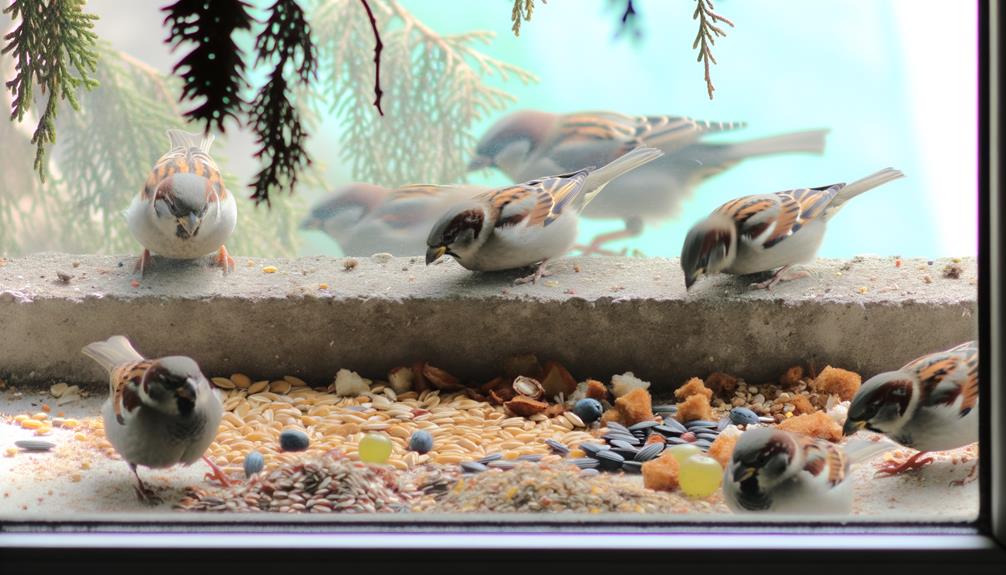
Grey sparrows are primarily attracted to food sources such as seeds and grains, which provide important nutrients for their diet.
Insects and spiders also play a pivotal role, offering protein necessary for growth and reproduction.
Additionally, fruit and berries contribute vitamins and energy, enriching their dietary diversity.
Seeds and Grains
Observations and research indicate that sparrows are particularly attracted to a variety of seeds and grains, including millet, sunflower seeds, and cracked corn. These food sources are high in essential nutrients, providing the energy and sustenance sparrows need for survival and reproduction.
Millet, for instance, is a small seed that sparrows can easily consume, while sunflower seeds offer high-fat content beneficial during colder months. Cracked corn is another preferred option, being both accessible and nutritious. Studies have shown that these seeds and grains can notably increase sparrow visitation rates at feeding sites.
Providing a mix of these food sources on window ledges can create an inviting environment, promoting frequent sparrow activity and offering a unique opportunity for close observation.
Insects and Spiders
In addition to seeds and grains, sparrows are drawn to insects and spiders, which serve as important protein sources for their diet. Research shows that these small birds actively hunt for beetles, caterpillars, and various arachnids, especially during the breeding season when protein demands are higher.
Observational studies indicate that sparrows frequent areas with abundant insect populations, such as gardens and window ledges with spider webs. Their keen eyesight allows them to spot tiny prey, and their agile movements enable quick capture.
Entomologists have noted that providing a habitat with diverse insect life can greatly enhance sparrow presence. The presence of spiders and insects at your window ledge likely attracts these opportunistic feeders, boosting their nutritional intake.
Fruit and Berries
Studies have shown that sparrows are also attracted to a variety of fruits and berries, which provide essential vitamins and antioxidants in their diet. Research indicates that sparrows commonly consume fruits like apples, grapes, and cherries, as well as berries such as elderberries, blueberries, and mulberries.
These food sources not only offer nutritional benefits but also provide hydration, especially crucial during warmer months. Observations reveal that sparrows are particularly drawn to brightly colored fruits, which are easier to spot from a distance. Additionally, these birds often forage in areas where fruit-bearing plants are abundant, capitalizing on the seasonal availability.
Weather and Seasonal Influences
Numerous studies show that grey sparrows' behavior and presence on window ledges vary greatly with changes in weather patterns and seasonal shifts.
During warmer months, these birds are more frequently observed gathering materials for nesting and seeking shelter in shaded areas. In contrast, during colder periods, grey sparrows often appear on window ledges, drawn to the warmth radiating from buildings.
Rainy seasons also influence their behavior, as they seek dry, elevated spots to avoid getting wet. Researchers have noted that sparrows' food-seeking activities peak during spring and autumn when insects and seeds are abundant.
Hence, the presence of grey sparrows at a window ledge can often be predicted by understanding the prevailing weather conditions and seasonal cycles.
Symbolism in Different Cultures

Examining the symbolism of grey sparrows across different cultures reveals a fascinating tapestry of interpretations and beliefs.
In European folklore, grey sparrows often symbolize simplicity and diligence, reflecting their industrious nature.
Ancient Greek texts associate them with Aphrodite, representing love and passion, while Native American cultures view sparrows as messengers of joy and protection.
Chinese symbolism highlights their importance in conveying good fortune and harmonious family life.
Scientific observations indicate that these cultural interpretations are deeply rooted in the birds' behaviors and habitats.
By examining these global perspectives, one sees a complex narrative where grey sparrows embody various human values, influenced by ecological and sociocultural contexts.
This multi-dimensional symbolism enriches our understanding of these ubiquitous avian visitors.
Spiritual and Superstitious Beliefs
While grey sparrows are often seen as common birds, their presence has sparked a myriad of spiritual and superstitious beliefs across different cultures.
In ancient Rome, sparrows were considered symbols of household spirits, thought to bring good fortune.
In various Native American traditions, sparrows are believed to carry messages from the spirit world, acting as intermediaries between the living and the deceased.
Some cultures regard the sighting of a grey sparrow as a sign of forthcoming change or a reminder to remain vigilant.
Research indicates that these beliefs are deeply rooted in the bird's ubiquitous presence and its role in folklore. Understanding these beliefs requires examining historical records, cultural contexts, and anthropological studies, offering insights into humanity's connection with nature.
Behavioral Patterns to Note

In observing the grey sparrows frequenting the window ledge, their feeding habits reveal a preference for seeds and small insects, often seen pecking in a methodical pattern.
Nesting behaviors display a strong inclination towards constructing nests in sheltered, elevated locations, utilizing materials such as twigs, grass, and feathers.
These observed behaviors align with established research on Passer domesticus, providing insights into their adaptive strategies in urban environments.
Feeding Habits Observed
One notable feeding habit of grey sparrows is their preference for small seeds, which they expertly shell with their beaks before consumption. They exhibit a methodical approach, often selecting seeds from a variety of available sources, such as bird feeders, gardens, and wild grasses.
Researchers have observed that these birds tend to favor millet and sunflower seeds. Additionally, grey sparrows display opportunistic foraging behavior, occasionally consuming insects and small invertebrates to supplement their diet.
During colder months, they're known to frequent human habitations more often, taking advantage of easily accessible food sources. Their agile movements and keen eyesight enable them to spot potential food from considerable distances, ensuring their sustenance in various environments.
Nesting Behaviors Displayed
Throughout the breeding season, grey sparrows display distinct nesting behaviors characterized by their thorough selection of nesting sites and materials. Observations indicate that these behaviors follow specific patterns:
- Site Selection: Grey sparrows favor sheltered locations such as window ledges, under eaves, or in dense foliage to safeguard against predators and harsh weather conditions.
- Material Gathering: They collect a variety of materials, including twigs, grass, feathers, and even human-made items like string or paper, to construct their nests.
- Construction: The nest-building process involves both male and female sparrows, with a focus on creating a robust, cup-shaped structure to support and insulate the eggs and subsequent nestlings.
These behaviors guarantee the survival and success of their offspring.
Environmental Indicators
Observing the behaviors and population dynamics of grey sparrows can serve as a reliable metric for evaluating local environmental health. Researchers note that an abundance of grey sparrows often signifies a balanced ecosystem, as these birds thrive in environments with ample food sources and minimal pollution.
Conversely, a declining sparrow population may indicate environmental stressors such as habitat loss, pesticide use, or air pollution. Studies have demonstrated that sparrows are sensitive to changes in air quality and can act as bioindicators of environmental toxins.
How to Encourage or Deter Sparrows
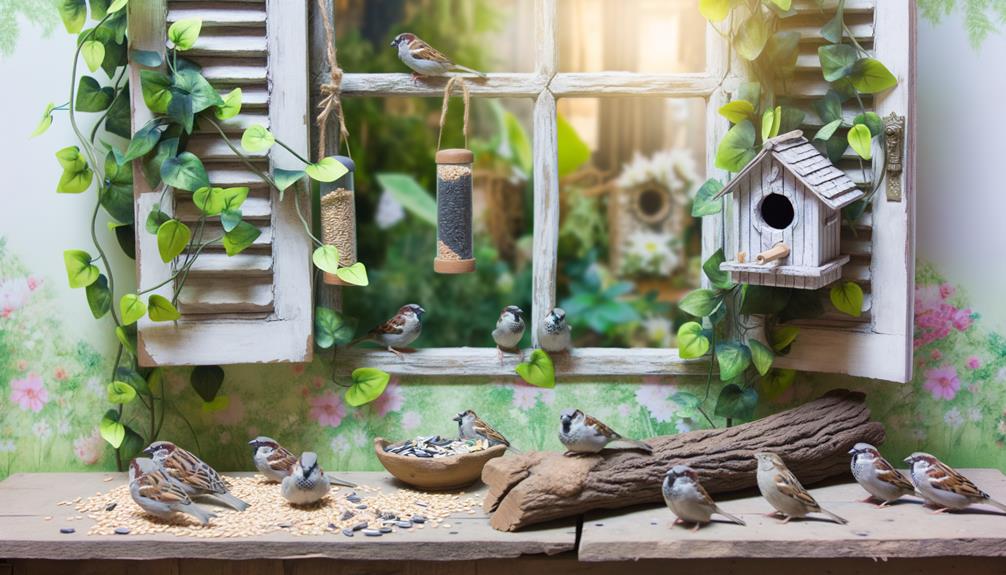
To encourage or deter grey sparrows, understanding their habitat preferences, food sources, and nesting behaviors is essential. Grey sparrows are attracted to environments that provide ample food, shelter, and nesting opportunities.
Key strategies include:
- Food Sources: Providing or removing bird feeders with seeds, grains, or breadcrumbs can either attract or deter sparrows. Research indicates they prefer millet and sunflower seeds.
- Nesting Sites: Installing birdhouses or blocking potential nesting areas such as eaves and cavities can influence sparrow presence. Studies show sparrows favor sheltered spots for nesting.
- Habitat Alterations: Adding or removing dense shrubbery and trees can affect sparrow populations. Scientific observations reveal that sparrows thrive in areas with ample cover and perching spots.
Employing these strategies can effectively manage grey sparrow interactions.
Personal Reflections and Observations
The observer documented consistent daily visits from grey sparrows, noting their habitual arrival at dawn and departure at dusk. These interactions elicited measurable emotional responses, including increased feelings of tranquility and reduced stress levels.
Such findings align with existing research indicating that regular encounters with urban wildlife can positively influence human psychological well-being.
Daily Sparrow Visits
Each morning, the grey sparrows arrive promptly at dawn, their presence marked by a series of sharp, rhythmic chirps that punctuate the otherwise silent stillness. These visits have been meticulously observed, revealing consistent behavioral patterns.
The sparrows exhibit:
- Feeding Behavior: They peck at the window ledge, likely searching for seeds or small insects.
- Social Interaction: The sparrows often engage in brief, yet complex, social exchanges, indicating a structured hierarchy.
- Territorial Signaling: Their chirps serve as auditory markers, reinforcing their claim over the ledge.
Research suggests that such repetitive behaviors are essential for their survival. Regular visits might indicate ample food supply, safe resting spots, and effective communication among the flock, underscoring the adaptive significance of these daily rituals.
Emotional Impact Observations
Observing the grey sparrows at the window ledge each morning evokes a profound sense of continuity and connection to the natural world. These avian visitors, with their regular patterns and interactions, provide a reliable, rhythmic presence that can reduce stress and enhance well-being.
Research indicates that birdwatching can lower anxiety levels, promoting mental clarity and emotional stability. The repetitive visual and auditory stimuli from the sparrows offer a soothing effect, acting as a form of natural therapy.
Additionally, the presence of these birds can foster a deeper appreciation for biodiversity and environmental stewardship. Therefore, the emotional impact of these daily encounters extends beyond momentary joy, embedding a lasting sense of tranquility and ecological mindfulness in the observer.
Conclusion
Observing grey sparrows at your window ledge, you're witnessing more than mere avian visits; these birds symbolize adaptability and resilience. Research indicates their presence can signal environmental health and seasonal shifts.
Whether they're seeking food or nesting space, their behavior offers rich insights into local ecosystems. Embracing or deterring them requires understanding their ecological role and cultural symbolism, ultimately reflecting your relationship with nature's delicate balance.
Sparrows are nature's messengers.


